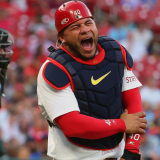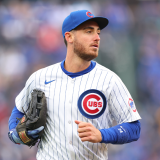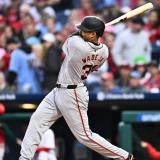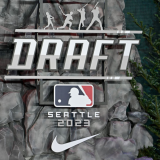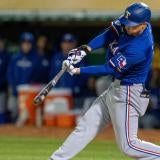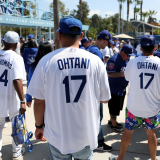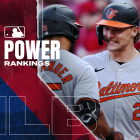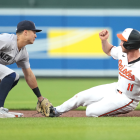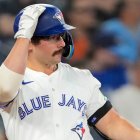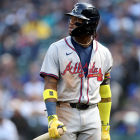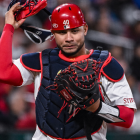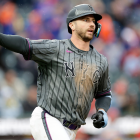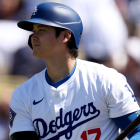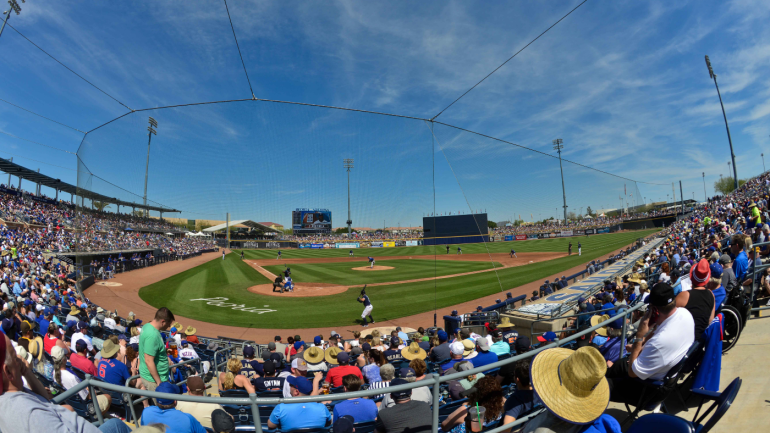
Spring training gets underway this week in Arizona and Florida, and that means some scene-setting in order. Specifically, what particular MLB storylines are worth your considered ruminations as pitchers and catchers report to camp? To be sure, many of the subplots about to be ticked off won't culminate during spring training, but the exhibition season may provide some hints as to how things might play out on that particular front.
Really, this is a non-exhaustive list of storylines for the 2021 season, and Cactus and Grapefruit League activity merely marks the start of those stories. Throat-clearing? Finished. Actual content of note? Beginning now …
1. The Mets and a Francisco Lindor extension
The Mets under new owner Steve Cohen have been quite active this offseason -- ludicrously active by the franchise's Wilpon-era standards -- and their centerpiece addition is All-Star shortstop Francisco Lindor, whom they acquired via trade with Cleveland. Lindor is a true difference-maker with the bat and the glove and on the bases, and he's also one of the most luminous personalities in the game today. He makes the Mets a better team on the field and a more alluring one off it.
The rub, though, is that Lindor is entering his walk year, which means he'll be eligible for free agency not long after the 2021 World Series ends. Without question, the Mets would love to sign Lindor to a multi-year extension so that his stay in Queens spans much longer than a mere one season. For his part, Lindor has expressed a willingness to do just that. However, it's going to come at a significant cost, and the clock is already ticking.
On that latter point, here's what Lindor at his introductory Mets press conference said about the timeline for signing an extension:
"It gets to a point in spring training and it is time to enjoy the ride and focus on winning."
The implication is that once Grapefruit League play gets going in earnest, the time for contract talk has passed. That, in turn, would mean that Lindor is almost certain to hit the market next winter. The Mets can't let that happen, and they need to be willing to pay Lindor something well north of $300 million in order to keep him in orange and blue (and occasionally black for some reason) for years to come. We may know the end of this particular story fairly soon.
2. The Dodgers and their chances of repeating
Not since the 1999-2000 has a team repeated as World Series champions. That happens to be the longest "repeat" drought in MLB history. The 2021 Dodgers, however, figure to have about as good a chance as you can have to win back-to-back titles. In the abbreviated 2020 season, they won at a .717 clip, which scales to a 116-win pace across the usual 162 games. They backed it up with a plus-136 run differential (a fairly absurd figure across just 60 games), and then in the postseason went 13-5 en route to winning the World Series for the first time since 1988.
As for 2021, they've added to the fold Trevor Bauer, who was the top pitcher available on the free-agent market, and veteran lefty David Price will be new to the rotation after opting out of the 2020 season. The pitching depth is the envy of every other team, and they return almost every piece of an offense that led the majors in runs scored last season.
The nature of baseball is such that you should always take the field over any one team when it comes to predicting who wins the World Series, but the mighty Dodgers are better positioned to repeat than any team in a very long time.
3. Fans in the stands
Because of the still ongoing COVID-19 pandemic, fans weren't permitted to attend MLB games last season until the very last rounds of the playoffs. This season, however, figures to occasion more of an atmosphere of normality in this regard. The plan right now is for fans to be in attendance at spring training games and regular season games, albeit in limited numbers and in accordance with local guidelines.
Back in January, MLB distributed an internal memo on this matter that went a little something like this:
"The Office of the Commissioner understands the need for clubs to plan for next season,'' the memo reads, "but MLB's policies ultimately will depend on the public health situation in the United States, which is difficult to predict this far in advance of the season. In particular, the current uncertainty surrounding COVID-19 vaccine production and distribution rates is preventing our experts from making predictions about the spring and summer with specificity. As such, MLB's guidance on fan attendance may change in the coming weeks as circumstances change, and may also be modified later as the season progresses and conditions improve. ...
"Changes in government orders, particularly at the federal level, may necessitate changes to MLB's policies."
MLB likely will be following the same formula it used during the World Series -- i.e., requiring fans to wear masks and selling tickets to "pods" of fans who will maintain social distance between other pods. Again, tickets will be sold in limited numbers, and it's hard to imagine that we'll see anything more than 20-25 percent capacity at any venue in the early weeks of the season. As noted, local regulations will be determinative in many regards.
Obviously, as more and more people get vaccinated, it seems likely that attendance restrictions will be gradually loosened (assuming emerging COVID variants don't complicate matters). If herd immunity is indeed achieved by summer, which increasingly seems like a plausible goal, then you could see normal-ish attendance figures for the stretch drive and postseason. And wouldn't that be a welcome thing.
4. The Astros and their uncertain villain status
Speaking of fans in attendance, the Astros -- pursuant to the sign-stealing scandal that roiled baseball before COVID came along -- have yet to receive a truly vigorous booing by paying customers. Last season, no fans attended any regular season Astros games even as they advanced as far as the ALCS, so they've yet to hear about their transgressions in the typical manner.
The passage of time tends to blunt righteous outrage, and many of the key villains -- A.J. Hinch, Alex Cora, Jeff Luhnow, Carlos Beltran, and others -- have moved on elsewhere. That said, the sight of holdover Astros hitters like Alex Bregman, Jose Altuve, and Carlos Correa playing in front of fans on the road for the first time since the scandal was laid bare will surely conjure up some of those latent hostilities.
So are the Astros still villains? Maybe we'll know more when they visit the Yankees for a three-game set that starts May 4. You'll recall that the Astros felled the Yankees in the perhaps tainted 2017 ALCS. Then they may be in for another round of robust heckling from the hoi polloi on Aug. 3 and 4 when they travel to L.A. for a pair against the Dodgers. You'll recall that the Astros defeated the Dodgers in seven games in the 2017 World Series. While Joe Kelly has already had his say, Dodger fans have not.
5. The Blue Jays as AL East contenders
To hear our hive mind tell it, the Yankees are the favorites in the AL East in 2021, and let's not forget that the Rays are the reigning AL champs. The Red Sox also figure to be at least vaguely relevant. So where does that leave the Blue Jays?
Wherever it leaves them, they're to be taken seriously. They're coming off a resurgent 2020 season in which they finished four games above .500 and made the expanded postseason. That constitutes a huge leap over 2019, when they went 67-95. When a team makes such huge strides from season to season, you worry about en masse regression back to the mean -- Bill James termed it the "plexiglass principle."
The Blue Jays, though, have attempted to preempt such nebulous laws by fortifying the roster with notable additions like George Springer, Marcus Semien, Kirby Yates, and Steven Matz. Those all move the needle, and that's especially the case once you consider that the Yankees and Rays at best held serve and shed some talent, respectively. It's also possible that the young to young-ish bats in the Toronto lineup will continue to enjoy skills growth. Maybe Toronto isn't the favorite in the division, but no one should be surprised if they wind up threatening 90 wins and making the postseason once again.
6. The powerhouse Padres
As noted above, the Dodgers by any measure look like the best team in MLB heading into the 2021 season. The NL West, as it turns out, may also house the second-best team in MLB. That would be the Padres.
Last season, the Padres busted out in a big way, as they won at a .617 clip -- the best win percentage in franchise history -- and returned to the playoffs for the first time since 2006. That was largely because the impressive young talent base and targeted free agent additions gelled at the same time. Now those core contributors are back, and GM A.J. Preller has complemented them with a veritable offseason haul. This winter, the Padres have signed or traded for the likes of Yu Darvish, Blake Snell, Joe Musgrove, Mark Melancon, and Ha-seong Kim. All that for a roster that didn't seem to have many glaring needs.
Yes, the Dodgers remain the favorites, but the Padres aren't far behind them in terms of roster strength. That means the NL West race could double as a fight to determine the best team in baseball in 2021.
7. La Russa rides again
The up-and-coming White Sox ended their postseason drought last year, and thanks largely to the fruits of the rebuild they're well positioned to contend for years to come. That's why it was a puzzling decision to part ways with manager Rick Renteria. More puzzling still was the decision -- likely made from on high -- to replace him with Tony La Russa.
La Russa is a Hall of Fame manager, but he's also 76 years old and hasn't managed an MLB game in almost a decade. He'll become the third-oldest person ever to manage an MLB game, trailing just Connie Mack and Jack McKeon. No one doubts La Russa's smarts or his profoundly impressive dossier. What's doubted is whether he's a good fit for a roster that leans young and new school. It's a high-risk hire, particularly in light of La Russa's past legal issues.
Spring training play should provide some insight into how La Russa will skipper his talented team in 2021, and it may give some insight into how well his charges respond to said skippering. For good or ill, the outcome of this unlikely pairing of team and manager will be compelling.
8. Arenado's bat
It's too much to say the NL Central will hinge on how well Nolan Arenado produces in his first season with the Cardinals, but it may be the biggest single X-factor in what still looks like a tight division (note: we said "tight," not "good").
This is a bit of an unknown not because of Coors Field. Look, we have plenty of examples of Rockies hitters going on to thrive elsewhere, and DJ LeMahieu is just the most recent example. Yes, Arenado's home numbers will almost certainly decline now that he's no longer playing those home games at a mile above sea level, but playing home games in Coors Field also tends to mangle a hitter's road performance. Arenado in St. Louis will no longer have those concerns, which is why his performance in road games should improve. Call it a wash, basically, at least on a park-adjusted level.
No, the concern is Arenado's declining batted ball metrics. Since 2018, Arenado's quality of contact measures such as average exit velocity, expected batting average, expected slugging percentage, and hard-hit rate have all trended in the wrong direction. It's easy enough to dismiss last season's disappointing outputs because of Arenado's early shoulder injury (in addition to, you know, playing a 60-game schedule in the midst of a pandemic). However, his issues with making good contact didn't begin last year. Those indicators can be telling when it comes to future performance, and Arenado will soon be into his thirties.
None of this is to suggest that Arenado is in decline or that the Cardinals erred in acquiring him. He's still likely to be a quality hitter for some time, and that's to say nothing of his still excellent defense. Rather, it's fair to wonder whether Peak Arenado, at least at the plate, is gone for good. On that front, the 2021 season will be quite telling.
9. The Angels' latest attempt to build a winner
Once again, the annual consideration out in Orange County is whether the Angels have done enough to surround Mike Trout, still the best player in baseball, with a playoff-worthy supporting cast. Going into 2021, you can reframe it as whether the Angels have done enough to surround Trout and Anthony Rendon with a playoff-worthy supporting cast. The Angels haven't made the playoffs since 2014, and that's the only time they've advanced to the postseason during Trout's singular peak. For shame.
Drill down a bit, and you'll find that this is largely a matter of the rotation. For the past half-decade plus the Angels have trotted out some of the worst heaps of starting pitchers in all of baseball, and no matter the brilliance of your legendary center fielder it's hard to win with a dead-weight rotation. So will 2021 be any different under first-year GM Perry Minasian? They've added Jose Quintana and Alex Cobb to the rotation, and they should at least be good for volume innings. There's also the possibly quixotic hope that Dylan Bundy truly leveled up in a sustainable way last season, and Andrew Heaney projects as a solid-average. Is that enough? It might be, but bear in mind that we're back to a 10-team playoff field for 2021. The sensible assumption is that Trout will once again be home by October, but it would be nice to be wrong about that one of these years.
10. CBA tensions and run-up
Insofar as off-the-field matters are concerned, the 2021 season is prelude to a potential labor war. That's because the current Collective Bargaining Agreement (CBA), which is the negotiated document that governs the working relationship between players and owners, is set to expire on Dec. 1. MLB has had an unprecedented run of labor peace, but that peace has become an uneasy one.
Owners in the next round of CBA negotiations will no doubt want to come away with an expanded postseason while in exchange giving up as little as possible. The players, meantime, want to address their declining share of league revenues through structural means. To accomplish that, the players may need to address tanking, work to lessen the penalties of the luxury tax, win assurances against service time manipulation, and reconfigure the structure of free agency. Those are all very heavy lifts.
Layer on top of that the tensions stemming from ownership's bad-faith posturing leading up to the 2020 and 2021 seasons, and it's entirely possible that we see MLB's first labor stoppage since 1994-95. That could take the form of a December lockout by owners, or the players could strike in an effort to win concessions from the league. Either way, the guess right now is that it'll be an ugly process.
In the meantime, let's play some baseball.







